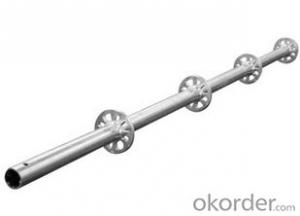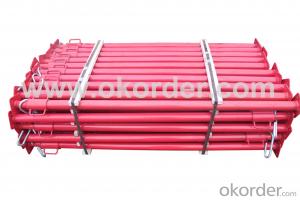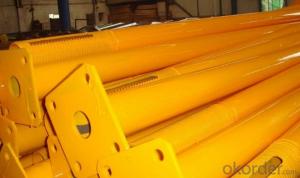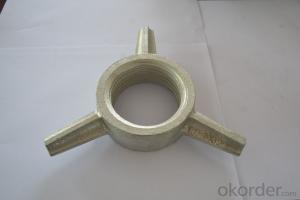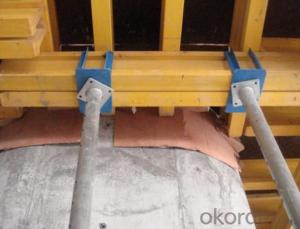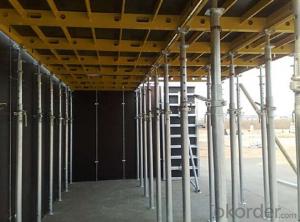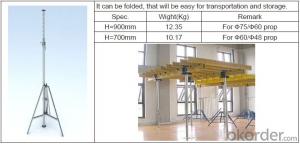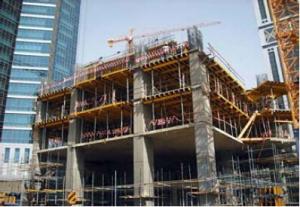Scaffolding System Ringlock Scaffold Vertical
- Loading Port:
- China Main Port
- Payment Terms:
- TT OR LC
- Min Order Qty:
- -
- Supply Capability:
- -
OKorder Service Pledge
Quality Product, Order Online Tracking, Timely Delivery
OKorder Financial Service
Credit Rating, Credit Services, Credit Purchasing
You Might Also Like
Quick Details
| Scaffolding System: | Material: | Diameter: | |||
| Surface: | PacKing: |
Packaging & Delivery
| Packaging Detail: | Pallets or As Customer's Requirements |
| Delivery Detail: | 30Days |
Specifications
1.Manufacturer
2.Custom Made: Available
3.Material: Q235 or Q345
4.Surface: Galvanized or Painted
Details
Ring Lock Scaffolding System
OEM service is available
Scaffolding System: Ringlock Scaffolding System
Material: Q235 or Q345
Surface Treatment: Galvanized or Painted or HDG or Powder Coated
Packing: Pallets or As Customer's Requirements
Delivery Time: 30 Days
Auto Welding Machine
A full set of ringlock scaffolding parts offered
Simple and officient to assemble
Specification
| Item Name | Cuplock Scaffolding | |
| Brand Name | Queen | |
| Raw Material | Q235 /Q345steel Grade | |
| Components | Standard.Ledger .Diagonal brace. Top/Bottop Cup/ Ledge Blade | |
| Surface finish | Electric Galvanized/HDG/Powder coated | |
| Size | Pipe size:48.3mm | |
| Thickness:3.25mm | ||
| Usage | Widely used in Bridge .Tunnel.Peterifaction.Shipbuilding .railway,Airport. Dock Industry and Civil Building | |
| Packing | By Steel pallet or bulk | |
- Q:Can steel props be used for supporting temporary roofs?
- Yes, steel props can be used for supporting temporary roofs. Steel props are commonly used in construction to provide temporary support and stability to structures, including temporary roofs. Their strength, adjustable height, and stability make them suitable for supporting the weight and load of temporary roofs.
- Q:Can steel props be used in both residential and commercial construction?
- Yes, steel props can be used in both residential and commercial construction. Steel props, also known as adjustable steel props or steel acrow props, are versatile and can support heavy loads during construction. They are commonly used to support formwork, ceilings, beams, and walls. In residential construction, steel props can be used to provide temporary support for load-bearing walls during renovations or alterations. They are particularly useful in situations where walls need to be removed or openings need to be enlarged. Steel props can also be used to support temporary structures such as scaffolding or to provide additional support to weak or damaged structures. In commercial construction, steel props are widely used for various applications. They can be used to support beams or slabs during concrete pouring, ensuring the structural integrity of the building. Steel props are also commonly used in shoring systems to support excavation works, enabling safe construction in deep trenches or basements. Overall, steel props offer a reliable and efficient solution for temporary structural support in both residential and commercial construction. They are adjustable, easy to install, and can withstand heavy loads, making them suitable for a wide range of construction projects.
- Q:What are the alternatives to steel props?
- There are several alternatives to steel props that can be used for supporting structures during construction or renovation projects. Some of these alternatives include: 1. Aluminum props: Aluminum props are lightweight and provide a high strength-to-weight ratio. They are easy to handle and transport, making them a popular choice for temporary support in construction projects. Additionally, aluminum props are resistant to corrosion, which makes them suitable for use in humid or coastal areas. 2. Timber props: Timber props, also known as wooden props, are a traditional and cost-effective alternative to steel props. They are commonly made from high-quality timber, such as hardwood, and can be easily adjusted to the required height. Timber props are lightweight, easy to handle, and can be used for various construction applications. 3. Adjustable telescopic props: Telescopic props are made from materials like aluminum or fiberglass and feature an adjustable length mechanism. They can be easily extended or retracted to fit the desired height and provide support for different types of structures. These props are commonly used in applications where variable heights are required or where space is limited. 4. Hydraulic jacks: Hydraulic jacks are another alternative to steel props and are often used for heavy-duty applications. These jacks use hydraulic pressure to raise and support heavy loads. They are commonly used in industrial settings or for lifting and supporting structures like bridges or buildings during construction or maintenance. 5. Screw jacks: Screw jacks are mechanical devices that use a threaded rod and a nut to provide support. They can be adjusted to the desired height by rotating the rod, allowing for precise leveling and support. Screw jacks are commonly used in applications where a stable and adjustable support system is required, such as in temporary structures or formwork. It is important to consider the specific requirements of the project and consult with a structural engineer or construction professional to determine the most suitable alternative to steel props based on factors such as load-bearing capacity, durability, and cost-effectiveness.
- Q:What are the common accessories available for steel props?
- Steel props can be enhanced in functionality and safety with various common accessories. These accessories consist of: 1. Utilizing prop heads: These provide a stable surface for supporting beams or other structural elements. The adjustable prop heads easily attach to the steel props. 2. Employing prop connectors: These join multiple steel props together, allowing for longer spans or supporting structures. They ensure a secure connection, increasing stability and load-bearing capacity. 3. Implementing adjustable base plates: These plates attach to the bottom of the steel props, offering a wider surface area for load distribution. They can be adjusted to accommodate uneven ground or achieve the desired height. 4. Incorporating guardrails: Guardrails are essential safety accessories that prevent falls from elevated platforms. They create a barrier around the working area, reducing accidents and providing a safe environment. 5. Utilizing prop sleeves: These sleeves protect steel props from damage during transportation or storage. Designed to fit snugly, they prevent scratches, dents, or corrosion. 6. Employing prop pins and clips: These small accessories secure the adjustable parts of steel props, preventing accidental movement or collapse and ensuring structural integrity. 7. Implementing prop braces: Braces provide additional support and stability for steel props, especially when facing heavy loads or extreme conditions. 8. Utilizing prop storage racks: These racks are specifically designed for storing unused steel props. They organize and protect props, prolonging their lifespan and ensuring easy accessibility. These accessories not only enhance the performance and versatility of steel props but also contribute to overall construction site safety. It is crucial to select appropriate accessories based on project requirements and ensure proper installation and maintenance.
- Q:Are steel props suitable for supporting scaffolding systems?
- Steel props, referred to as adjustable steel props or steel acroprops, are frequently employed in the construction and scaffolding sectors to offer temporary support to structures, including scaffolding systems. Crafted from top-tier steel, these props possess exceptional strength, durability, and the ability to withstand substantial loads. Their height is adjustable, granting versatility and adaptability for a variety of construction endeavors. Installation is straightforward, and they provide steadfast support, guaranteeing the safety and stability of scaffolding systems. In conclusion, steel props offer reliability and are an appropriate option for supporting scaffolding systems.
- Q:Are steel props suitable for supporting cantilever structures?
- Depending on the design and load requirements of a cantilever structure, steel props may be a suitable option for providing support. Steel props possess considerable strength and durability, which enables them to offer the necessary support for cantilever structures. Nonetheless, it is crucial to ensure that the props are correctly sized, installed, and braced to effectively handle the loads and forces exerted by the cantilever structure. Moreover, factors such as the length of the cantilever, the material utilized for the structure, and the environmental conditions need to be taken into account in order to determine the suitability of steel props. To assess the specific requirements and identify the most appropriate support system for a cantilever structure, it is advisable to consult with a structural engineer or construction professional.
- Q:What safety precautions should be taken while using steel props?
- When using steel props, it is important to take certain safety precautions to ensure the well-being of workers and prevent accidents. Here are some safety measures that should be taken while using steel props: 1. Proper training: Workers must undergo thorough training on the correct usage, assembly, and disassembly of steel props. They should also be educated about potential hazards and how to mitigate them. 2. Equipment inspection: Before using steel props, they should be inspected for any signs of damage, such as cracks, bends, or rust. Faulty props should never be used, as they can compromise safety. 3. Load capacity assessment: It is crucial to determine the load capacity of the steel props and ensure that it is not exceeded. Overloading can result in collapse or failure, leading to serious injuries or even fatalities. 4. Secure placement: Steel props should be securely positioned and braced to prevent accidental movement or collapse during use. They should be installed on a stable and level surface, and any necessary shoring or bracing techniques should be employed. 5. Regular maintenance: Regular maintenance and inspections should be carried out to identify and address any wear and tear or potential issues with the steel props. This includes lubricating moving parts, checking for loose or damaged components, and replacing any worn-out parts. 6. Personal protective equipment (PPE): Workers should always wear appropriate PPE, such as safety helmets, steel-toed boots, gloves, and eye protection, to protect themselves from potential falling objects or debris. 7. Communication and coordination: Effective communication and coordination among workers is essential to ensure the safe use of steel props. Clear instructions should be provided, and workers should be aware of their roles and responsibilities. 8. Emergency preparedness: Workers should be familiar with emergency procedures and have access to first aid kits and fire extinguishers. In case of an emergency, they should know how to evacuate the area safely. By following these safety precautions, the risk of accidents, injuries, and property damage can be significantly reduced while using steel props. It is essential to prioritize safety at all times and to make sure that all workers are trained and equipped to handle the equipment properly.
- Q:Can steel props be used in different weather conditions?
- Yes, steel props can be used in different weather conditions. Steel is a strong and durable material that can withstand various weather conditions such as rain, wind, and extreme temperatures. However, it is important to ensure proper maintenance and protection to prevent rust and corrosion that can be caused by prolonged exposure to harsh weather elements.
- Q:What are the potential legal or regulatory requirements for using steel props?
- The potential legal or regulatory requirements for using steel props may vary depending on the jurisdiction and specific industry. However, some common requirements could include ensuring compliance with workplace health and safety regulations, obtaining necessary permits or licenses for construction projects, adhering to building codes and standards, and conducting regular inspections and maintenance to ensure the props are safe and fit for use. It is important to consult with local authorities and relevant industry regulations to determine the specific legal or regulatory requirements for using steel props in a particular context.
- Q:Do steel props have any adjustable locking mechanisms?
- Yes, steel props often have adjustable locking mechanisms. These mechanisms allow users to easily adjust the height and stability of the steel props to suit their specific needs. The most common type of adjustable locking mechanism used in steel props is a pin and hole system. This system allows users to select the desired height by inserting a pin into one of the pre-drilled holes on the prop. Once the pin is inserted, it securely locks the prop at the desired height. Some steel props may also feature additional locking mechanisms such as a screw or lever mechanism for added stability and security. These adjustable locking mechanisms make steel props versatile and adaptable for various construction and support applications.
1. Manufacturer Overview |
|
|---|---|
| Location | |
| Year Established | |
| Annual Output Value | |
| Main Markets | |
| Company Certifications | |
2. Manufacturer Certificates |
|
|---|---|
| a) Certification Name | |
| Range | |
| Reference | |
| Validity Period | |
3. Manufacturer Capability |
|
|---|---|
| a)Trade Capacity | |
| Nearest Port | |
| Export Percentage | |
| No.of Employees in Trade Department | |
| Language Spoken: | |
| b)Factory Information | |
| Factory Size: | |
| No. of Production Lines | |
| Contract Manufacturing | |
| Product Price Range | |
Send your message to us
Scaffolding System Ringlock Scaffold Vertical
- Loading Port:
- China Main Port
- Payment Terms:
- TT OR LC
- Min Order Qty:
- -
- Supply Capability:
- -
OKorder Service Pledge
Quality Product, Order Online Tracking, Timely Delivery
OKorder Financial Service
Credit Rating, Credit Services, Credit Purchasing
Similar products
New products
Hot products
Related keywords
